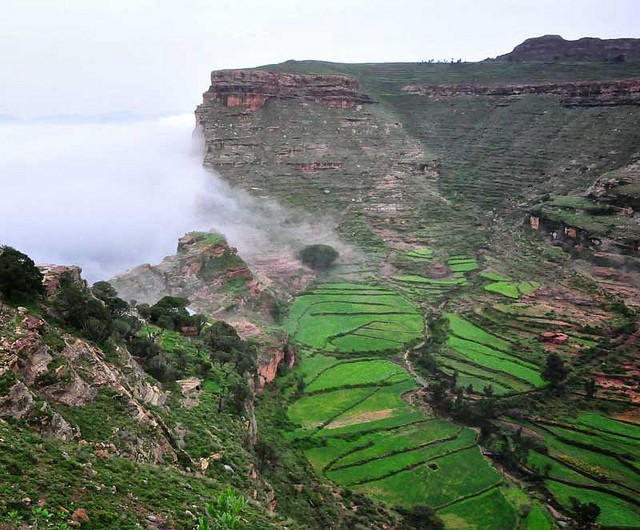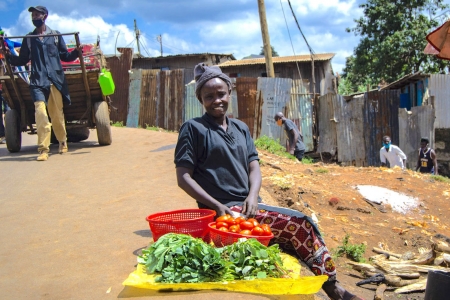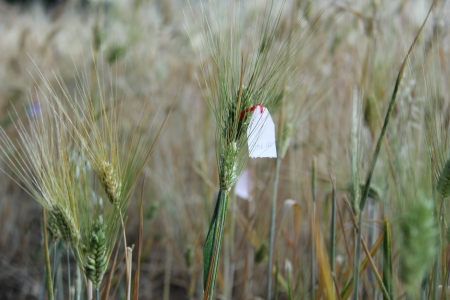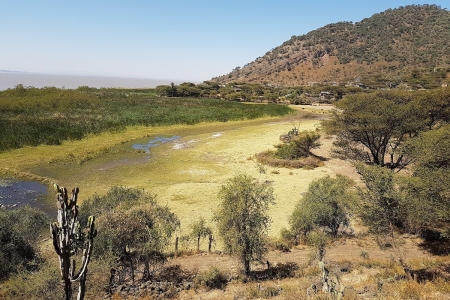This post is part of an online discussion on large-scale land interventions that runs through December 14, 2014. Can these initiatives fulfil their promises? Read more here and comment below or send an 800 word response to a.waldorf@cgiar.org.
Evidence and lessons from Ethiopia
Those who travelled across various parts of Ethiopia have witnessed the rugged and degraded landscapes. They have observed the enormity of environmental deterioration and might have wondered how an ‘Agricultural-led Industrialization’ could be possible in the country. Is the restoration of ecosystems and the creation of sustainable landscapes attainable, to support the current and future population?
 Terrace agriculture in Tigray, Ethiopia has improved production of previously degraded land. Photo: Rod Waddington on Flickr
Terrace agriculture in Tigray, Ethiopia has improved production of previously degraded land. Photo: Rod Waddington on FlickrEthiopia is one of the countries in the world that requires tremendous attention to sustainable land management and environmental protection and restoration. Cognizant of the economic, social and environmental costs of deforestation and natural resources degradation, the Government of Ethiopia has taken bold actions over the last two decades to reverse the trend.
A mosaic of interventions
Through continuous environmental sensitization, awareness creation, mass mobilization and engagement, the government has enhanced the solidarity of the rural society of Ethiopia and their continuous commitment in environmental rehabilitation works and campaigns, including the contributions of ‘free labor’ for the last decade.
Against this background, the government took plausible efforts to tackle land degradation and restore degraded areas through sustainable land management options. Recently, the country has also adopted a Climate Resilient Green Economy strategy aiming to fine-tune agricultural and development interventions suited not only to improve livelihoods but also to protect and sustain the integrity of the environment.
Thanks to the wider public and government engagement for the last decades and the support rendered by different partners, the government has invested significantly in a landscape based watershed management practices, where mosaics of carefully selected interventions were implemented across the different positions of landscapes.
From the early 1990s, in addition to the supporting policies indicated earlier, the government has been investing in woredas (districts) through the Productive Safety Net Program (PSNP). However, the majority of the investment comes from the public engagement through mass mobilization.
Hence, millions of hectares of land have been exclosed for natural regeneration, billions of trees have been planted, million kilometers of terraces have been constructed, hundreds of thousands of hectares of land have been protected from unlimited livestock and human intervention and thousands of water harvesting and development schemes have been developed in various parts of the country.
From food insecure to food self-sufficient
Such initiatives brought communities like that of Abreha we-Atsbehain in the Tigray region to win the Equator Prize award 2012 by UNDP “in recognition of outstanding success in promoting local sustainable development solutions for people, nature, and resilient communities”.
Though the extent varies from place to place, evidence show that the landscape development and management interventions have brought tremendous impact on improving ecosystems health and livelihoods of millions of people. For instance, many households have managed to deposit money and started taking credit from financial institutions for different purposes.
Livelihood diversification from irrigation and improved livestock management enabled farmers’ access to healthy and nutritious food. More than 7,000 households in the Tigray region graduated from the PSNP; farmers moved from chronically food insecure to food self-sufficiency status.
The process: Communities, with the technical support from local government and development partners, identify communal areas that are severely degraded and require rehabilitation through a landscape approach. All village residents debate on, negotiate and finally decide on such areas either to be set aside as exclosures or get some sort of catchment management intervention.
Then the area is socially demarcated and protected. The villagers develop bylaws for governing the area, including a structure through which the bylaws are enforced. The community based bylaws related to the protection and management of the exclosure, for example, are recognized by the judiciary to influence the implementation. The community owns the practice and even does the promotion by themselves.
Key lessons learnt include:
1) Include the community during the initiation, planning and implementation of interventions
2) Design options to target different niches in landscapes so that integrated restoration practices at the landscape level will be complementary and ensure sustainability at local and watershed scales
3) Integrate physical and biological options, and design options such that short-term benefits embedded with long-term benefits are viable. Though there were lots of exciting achievements, there are some challenges that require attention:
a) what additional benefits should interventions such as afforestation and exclosures provide to communities to be more attractive and how can they be competitive?
b) what kinds of policy and institutional setups should be in place to promote efficient out-scaling of interventions to other areas?
These efforts have increased the greenness of the landscapes, improved access to forest products and rehabilitated many ecosystem services including carbon stock enhancement. Empowerment of local citizens through participatory processes in which they take the leading role in natural resources management and decision-making is vital step.
As the result, integrated watershed management and Community Based Natural Resources Management are the basic tools to be widely applied in the country, and these are also what have contributed to the achievement of huge environmental and forest rehabilitation successes in Ethiopia.
Sustaining the successes of efforts so far and to make these targets operational requires a huge capacity building (technical and institutional) and financial investment and public engagement. Therefore, Ethiopia calls for a support from all interested to change the faces of its landscape for the benefits of its citizens and beyond.
Dr. Tefera Mengistu is a panelist at the Global Landscapes Forum session: Large Scale Land Restoration - Creating the Conditions for Success on December 7th.












Comments
Dear Dr Tefera Mengistu,
We very much agree with you. Infact the video on the tale of two villages comparing the success of Abreha Atsebeha with Adi Gudom documents the process that you have outlined.
https://www.youtube.com/watch?v=GKmlAjuZ6Hw
We thank you and look forward to engaging with you further.
Dear ASDS
Thank you for the complementary note and additional information provided. Please follow on the opportunities and challenges which will be touched in the upcoming discussion.
Nice to see how Ethiopian communities are working to make ,safe their land scape
Great Success! I hope we can scale up this best practice.
Restoring degraded land is not a one season, year or decades event. one can not reach such big conclusion with short term effort.Where is the economics aspect considered? Can we talk confidently that much with this work really? Much ....done.
Thank you much
Add new comment